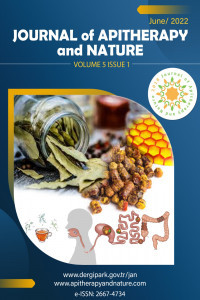Correlation between Phenolic Composition and Biological Properties of Propolis and Heavy Metal Contents
Correlation between Phenolic Composition and Biological Properties of Propolis and Heavy Metal Contents
Propolis, Heavy metal content, Phenolic Composition,
___
- .
- Yayın Aralığı: Yılda 2 Sayı
- Başlangıç: 2018
- Yayıncı: Oktay YILDIZ
Chemical Composition of Selected Propolis Samples from Kyrgyzstan and Kazakhstan
Argyro PETROPOULOU, Konstantia GRAIKOU, Jaroslaw WIDELSKI, Krystyna SKALICKA-WOŹNIAK, Zuriyadda SAKIPOVA, İoanna CHINOU
İbrahim PALABIYIK, Didem SOZERI ATIK, Esra BOLUK, Sevgi KOLAYLI
Carmen Violeta POPESCU, Hazem ABBAS, Stefan MANEA, Lili IVOPOL, Alina DUNE, Candice POPINIUC, Dumitru LUPULEASA
The Effects of Propolis on Growth Performance of Broiler Chickens
İvana KLARIC, Matija DOMACINOVIC, Berislav PRAKATUR, İvan MISKULIN, Bozica LACHNER, Dalida GALOVIC, Danijela SAMAC
Thirteen Flavonoids from Green Propolis from Minas Gerais, Brazil, Analyzed for Six Years
M. D. FREITAS, G. A. LOPES, N. A OLIVEIRA, B. M. ALMEIDA, S. R. L. ABREU, R. C. BASQUES, N. S. BINDA, S. M. FIGUEIREDO
Y. FRIÓN-HERRERA, D. GABBIA, M. CARRARA
Ahmad SULAEMAN, M MAHANI, HARDINSYAH HARDINSYAH, E DARMA, S. R. MUBAROKAH, N NURJANAH
İvan MISKULIN, İvana KLARIC, Matija DOMACINOVIC, Berislav PRAKATUR, Mirela PAVIC, Mario RONTA, Maja MISKULIN
GC-MS and UPLCA-PDA-TOF Profile of Polish and Eurasian Propolis
Jarosław WIDELSKI, Piotr OKIŃCZYC, Antoni SZUMNY, Jakub SZPERLIK, Anna KULMA, Zbigniew SROKA, Krystyna SKALICKA-WOŹNIAK, Tomasz MROCZEK
Hugo ALVES, Catarina PASSÃO, Maria João SOUSA, Cristina Almeida AGUIAR, Ana CUNHA, Rui Pedro OLIVEIRA
